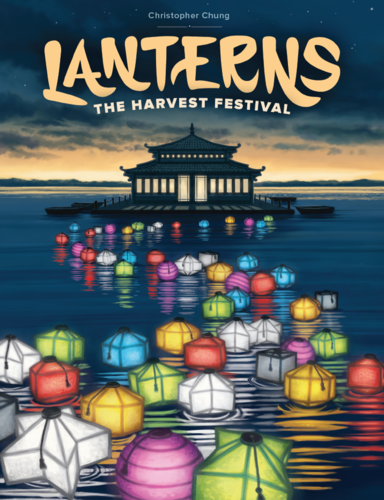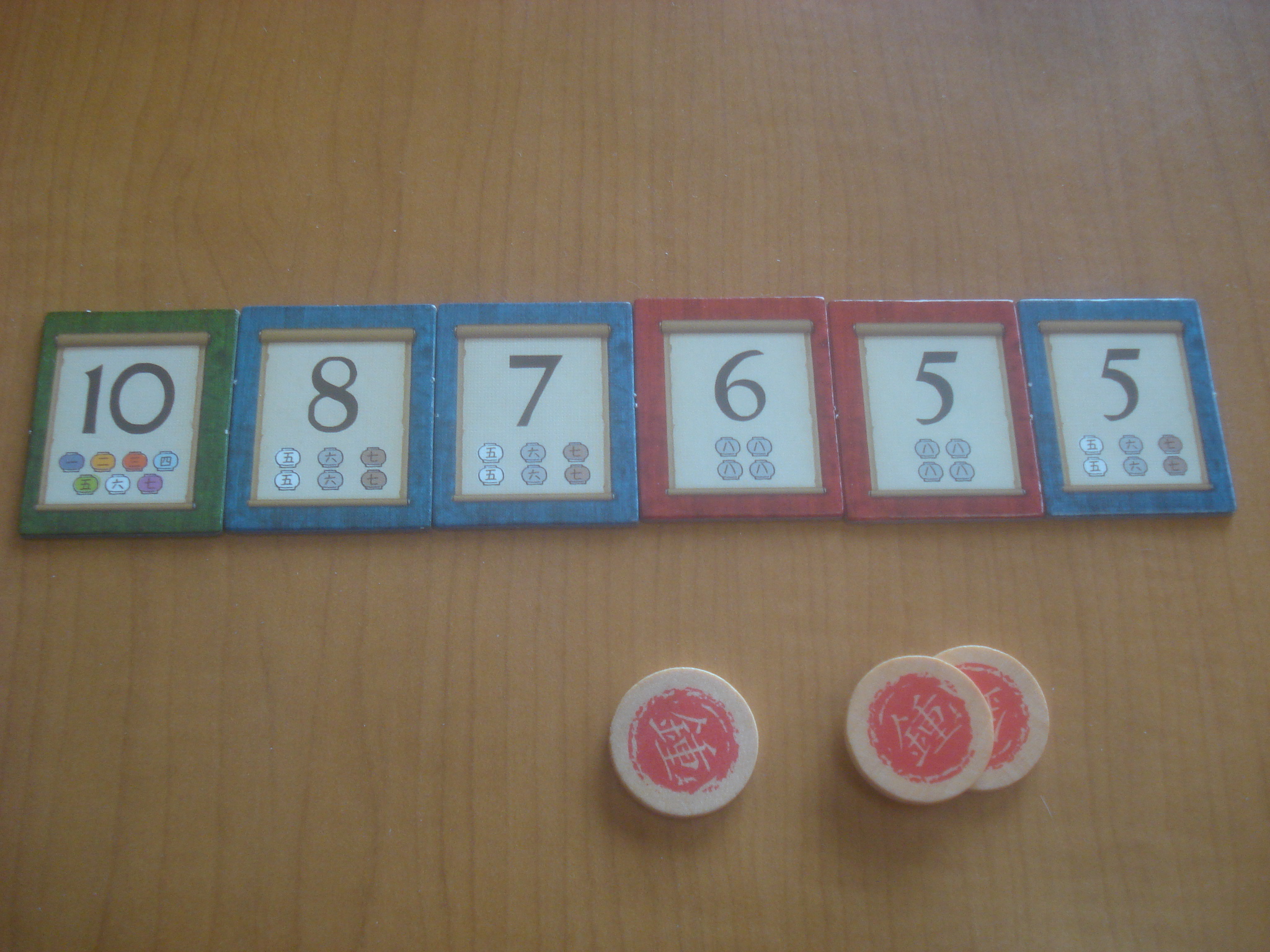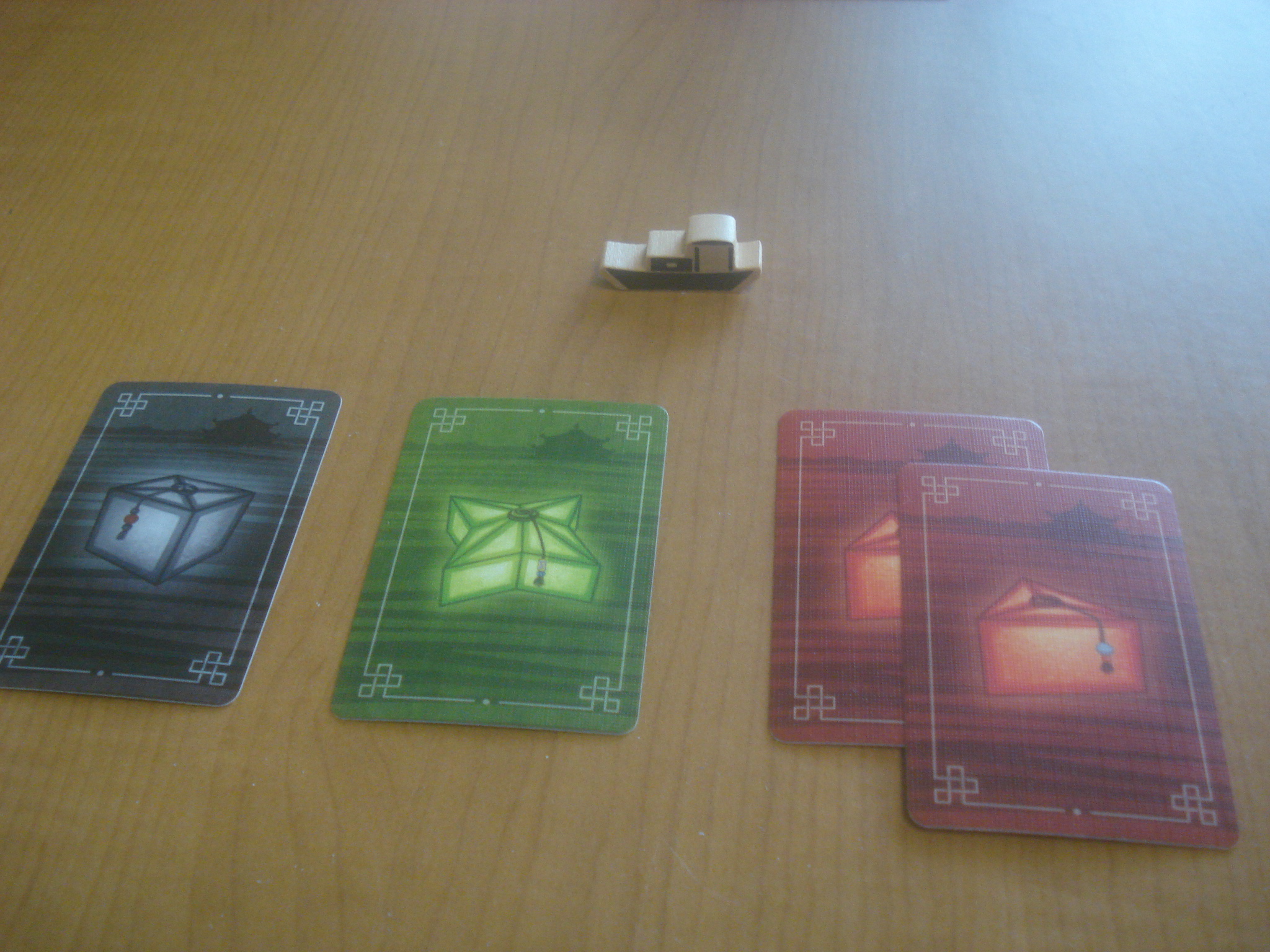| Publishers | Foxtrot Games and Renegade Game Studios |
| Design Credits | Christopher Chung, Sarah Stevens, Randy Hoyt, Tyler Segel |
| Art Credits | Beth Sobel, Jason D. Kingsley, Christina Major |
| Editing Credit | Dustin Schwartz |
| Game Contents | 56 Lantern Cards, 30 Dedication Tokens, one Start Tile, 36 Lake Tiles, 20 Favor Tokens, one wooden Start Player Marker, rules |
| Guidelines | Imperial Chinese tile-laying celebration |
| MSRP | $35 |
| Reviewer | Andy Vetromile |
Asian cultures use lanterns for a great many reasons – including lighting the way, of course, but more symbolically to represent wishes for fortune, a spouse, money, and a good crop. In Lanterns: The Harvest Festival the fields have been cleared and it’s time to celebrate with displays of lights spread out across the palace lake. Whoever creates the best show wins the most Honor and is celebrated for his artistry.
The object is to score the most Honor points for lantern displays.
Two to four players set out in a rowboat on a calm and beautiful lake with a handful of tiles showing different lantern colors on different sides. The artists dispense these next to tiles already played, and for every match they get a card of that color. For example, if someone placed a new tile beside an old one such that two blue sides touch he receives one blue card. Should their tile snuggle into the crook of an L-shape amid the tiles and match two sides, the player gets two cards, and so on.
The strategic snag is everything played may help the other players. The four sides of the tile grid face the four player positions. After the active player scores cards for matches he gets another card for the color of the tile edge facing him . . . and every other player gets a card matching their side of the played tile (hopefully not the one they needed to score Honor points). Additionally some tiles show Platforms, pretty pieces of artwork in their center, and if the active player’s match involves that Lake Tile he gets a Favor Token. Spending favors lets one trade a card he has for a color he wants from the bank.
Each turn the performers have the option of doing a dedication. These are the special point-scoring displays they put on for the crowd, and the three types require different card combos. One may turn in four of a kind (four cards of the same color); three pair (so long as each pair is a different color); or one of each (seven cards, one of each color featured in the game). He gets a token showing the Honor won for that dedication, though these pieces are in arranged stacks that decrease in value as players “purchase” them. When all Lake Tiles are drawn and placed everyone gets one more round to turn those hard-won cards into Dedication Tokens, and the highest Honor wins.
Lanterns: The Harvest Festival boasts a solid, pretty set of components. There’s a cute wooden boat to indicate first player, the tiles themselves are cheery and intricately executed, and the cards are of adequate material for the task at hand. The artwork is wonderful. warm, and delicate. On the other hand, the symbols on the dedication tiles, indicating which sets of cards buy which tokens, are terribly small. It’s fortunate there are only three types so they’re easy to remember but slightly larger graphics wouldn’t have hurt. The colors match up well between the tiles and the cards they earn – apologies to those masochists who like to squint at pieces and enjoy a good round of “Is that orange or red?” during play. The rules are short, sweet, and to the point, though not without a flaw in arrangement: The boat on the starting tile isn’t a Platform, but they don’t clarify this until the examples of play at the back of the book. They do sport plenty of those examples, a precedent from which more rulebooks could learn.
With an absurdly simple set of rules Christopher Chung has illuminated what’s possible with spare mechanics. Since you can orient a Lake Tile such that someone won’t get something because that color is out of stock, there’s just the right amount of interference possible to make it worth one’s while to stay on top of the competition. Part of the fun is trying to get what you want without giving up the store to one’s opponents, though this sometimes leads to analysis paralysis if someone examines every possible play and tries to anticipate anything everyone else might do. Players must decide what makes better sense this turn, denying the opponent the cards you think he wants or ensuring you have what you need – and hoping your intended dedication is still there next turn.
But someone’s going to get the right selection sooner or later so no one can focus solely on the politics of denial. Better to enrich oneself when one can . . . and even then you can snag first those dedications you think someone else wants. Learn which tile values come next and you know which reward stack to deplete in advance of your rivals. The game has plenty of room for add-ons and expansions, and the strategies are clever but not so involved that it takes all night. Lanterns: The Harvest Festival can come in under an hour so multiple plays in one night are easy – and even desirable, once you’ve seen the light.



